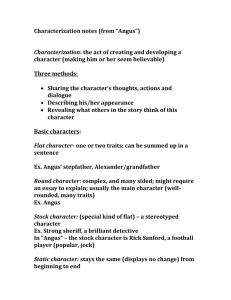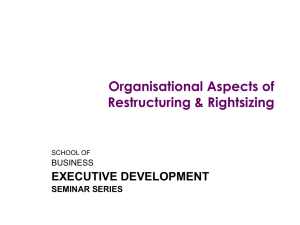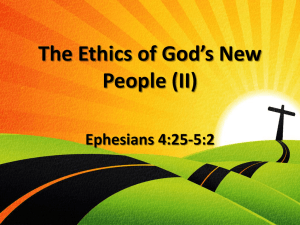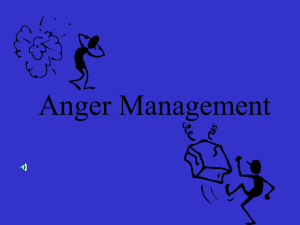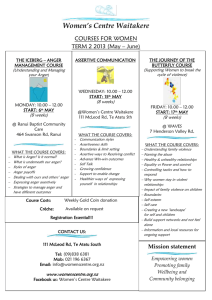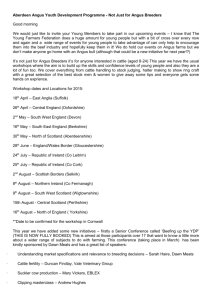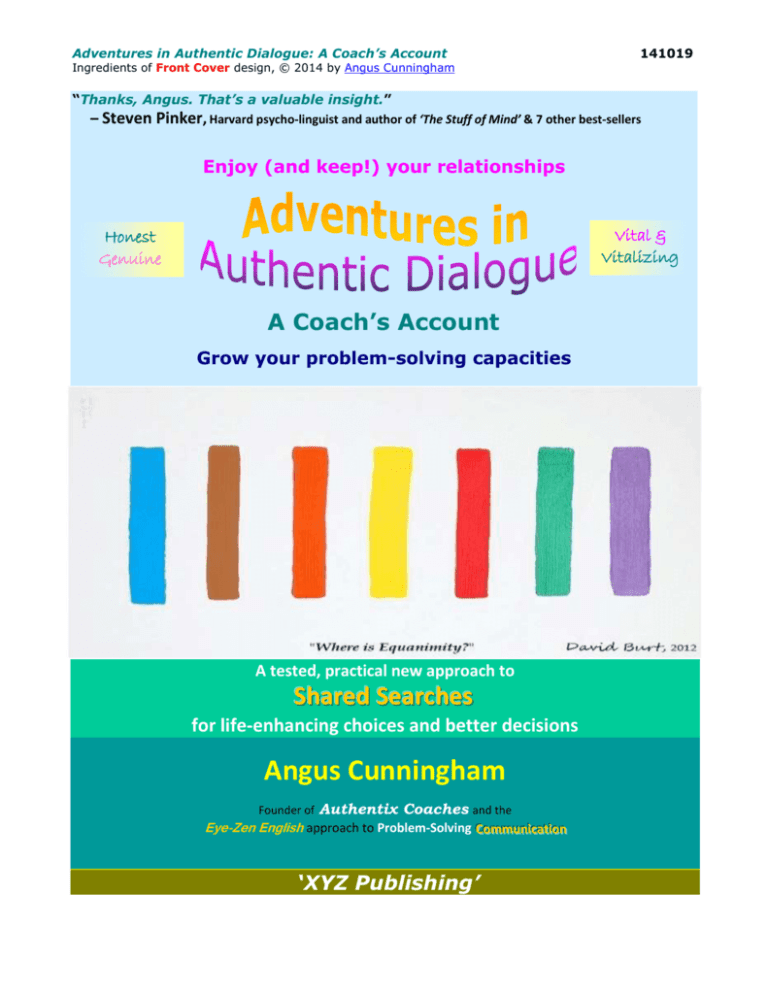
Adventures in Authentic Dialogue: A Coach’s Account
141019
Ingredients of Front Cover design, © 2014 by Angus Cunningham
“Thanks, Angus. That’s a valuable insight.”
– Steven Pinker, Harvard psycho-linguist and author of ‘The Stuff of Mind’ & 7 other best-sellers
Enjoy (and keep!) your relationships
Vital &
Vitalizing
Honest
Genuine
A Coach’s Account
Grow your problem-solving capacities
A tested, practical new approach to
Shared Searches
for life-enhancing choices and better decisions
Angus Cunningham
Founder of Authentix Coaches and the
Eye-Zen English approach to Problem-Solving CCoom
mm
muunniiccaattiioonn
‘XYZ Publishing’
Adventures in Authentic Dialogue: A Coach’s Account
141017
Graphic facing starting page of Preface © 2014 Angus Cunningham (2,200 words)
‘Thinking, Fast and Slow’
In the terminology of “Thinking, Fast and Slow” (by Nobel
Economics Laureate Daniel Kahneman, 2011), our 'System Two'
neurological resources can, if we ‘tell’ them to do so but not
otherwise, further process the outputs passed automatically to them
by our 'System One' resources. We can also influence, slowly but
deliberately, refinements to our automatic 'System One' processes.
In light of recent research findings about the phenomenon of ‘neuroplasticity’, might proficiency with IHXENs, a psycholinguistic term
explained in this book, help us channel the energy that spiritually
oriented people devote to growth in life wisdom into …
MORE ACCURATE problem-solving communication?
From First Guess to Reliable Insight
Sensing
Expressing
?
?
?
?
?
?
Intuiting, Interpreting,
Imagining, Remembering,
Organizing, Articulating,
Authenticating, etc.
Faster but
shallower
|
Slower but
deeper
(Drawing on the ideas of ‘Theory U’ in the writings of MIT’s Otto Scharmer)
© 2014 by Angus Cunningham. All rights reserved.
Permissions: angusc@authentixcoaches.com
P-1
Adventures in Authentic Dialogue: A Coach’s Account
141017
Preface + Table of Contents © 2014 Angus Cunningham (2,200 words)
Preface
"I have anger now!”
‘Blaze’ (c) 2012 by David Burt
None there had ever heard such a strangely fierce phrasing of words. Yet there was no
doubting his authenticity. The emotion of anger was plainly seen from his eyebrows
down through the muscles tensed in his jaw to the squared set of his slight torso. Yet
that very congruence of look and word seemed a guarantee that he knew his emotion
was anger, had adequate control of it, and was now only asking for attention he seemed
to know he merited. Someone the people there had never fully acknowledged before
was unignorably present. 10 or 15 long seconds passed before one of the six people
assembled in the Toronto boardroom where it took place in the summer of 2005 spoke.
Alan Bawks was one of seven who formed the Management Committee of National
Hydraulics. “Why do you have anger, Angus1?” he asked quietly, for it was indeed your
author whose extraordinary utterance had silenced the 5 other committee members
present that day in that boardroom. It was Alan who had been the first of the
committee to learn of my deep experience and faith in the extraordinary value of
scrupulously accurate honesty in problem-solving. And it was Alan who had first heard
how that faith rested on I-statements of a particular grammatical structure, of which I
have anger now is an extreme example. So I wasn’t surprised that it was Alan who
broke the silence, but I did feel a little relief.
I was there as an unpaid intern – a keen and experienced one, to be sure, yet still
unpaid. You weren’t there, of course, but if you had been, you would have known that
you and everyone else there had set aside time for the meeting, and that you had come
to solve a problem of urgent necessity to you and each of the others in it. Like everyone
there you would have had opportunity, and motivation too, to think about that fierce
outburst, about why it had occurred, and about what it might portend. How would you
have conducted yourself?
I deliberately used the third person, he, in my opening paragraph in the hope that readers who
know me may initially ‘hear’ that fiercely strange outburst as if it came from an unknown person.
In that way, I hope that any prior knowledge you may have of me will only minimally contaminate
your perception of the raw authenticity of that unconventional self-revelation, captured so
eloquently in David Burt’s painting
1
P-2
Adventures in Authentic Dialogue: A Coach’s Account
141017
Preface + Table of Contents © 2014 Angus Cunningham (2,200 words)
Would you have been polite and pretended you were following the response to Alan’s
question? Would you have requested or suggested a postponement? Would you, to
diffuse an atmosphere that had suddenly become emotionally charged, have invented a
distraction? Would you have pondered the speaker’s fierce demeanour: did it fit with
his/her words? Would you have wondered whether some crucial perspective was about
to emerge? Would you have summoned every ounce of your energy and ability to
concentrate to do so? How, actually, would you have thought, or acted?
The boss, Bill Boyko, National Hydraulics President and owner, was absent that day, so
no one was in the immediate sway of any established social hierarchy. Yet no one left;
and no one interjected a distraction or proposed an adjournment. In fact no one
remonstrated in any way. Everyone seemed to be watching to find out how an intern
who had commandeered the attention of everyone in the room with an observation that
everyone knew was socially and politically incorrect in the extreme
would respond to Alan’s question.
The trigger for my anger had been a fellow member of the committee
saying something that, had it been believed, would have trashed the
value of several months of volunteer work I had put in. But now that I
had let out some of my anger, it was less in control of me2. I had
become conscious of it enough to be presently aware that, if I didn’t use the energy of
my anger in a constructive way, I would be putting the value of that work at risk. So I
was using the silence to think hard about how to avoid losing, in my response to Alan’s
quiet empathy, the potential of that work to earn some credit from my fellow committee
members. It was allowing me to gather more of the reins of my wits to assess what now
was transpiring, and them, I feel quite sure, to pay close attention to my perspective.
I had been preparing for some moment like this for years. A statement with the
structure “I have anger now” is a psycho-linguistic invention, or rather re-invention3, of
mine from 1992 – a structure I had been practising ever since in private settings. But in
2005 a verbal admission of an emotion such as anger was ‘beyond the Pale’ of Canadian
corporate life, or indeed almost any corporate life in the English-speaking world,
although cracks in that custom are now appearing. As for Alan’s quiet enquiry, it had
revealed to me that he was not only wanting to express empathy for my unpleasant
experience; he was clearly also not far from equanimity. Might this be the opportunity I
was seeking? Could I take responsibility for my anger without accusing the person who
had triggered it of any malevolence? If so, might there be a possibility now, I was
thinking at the time, of proving the value of an unconventional verbal structure I had
been practising for so long?
When the generation now ready to retire was born most people were not paid in money
for their work. This generation entered a society in which the majority’s values derived
Nine years later, after reading “Thinking, Fast and Slow”, by Economic Science Nobel Laureate
Daniel Kahneman, I would learn that practice of the simple utterance of “I have anger now” would
slowly be giving me better control of the energy contained in my emotions of anger
3
Some evidence exists that it was first used in the Plantagenet Court of Henry V who was the
first king of England to order his Court to speak in English, 250 years after the Norman invasion
had made French the language of English Courts
2
P-3
Adventures in Authentic Dialogue: A Coach’s Account
141017
Preface + Table of Contents © 2014 Angus Cunningham (2,200 words)
mostly from those which fueled family life. In contrast, people born today can expect to
enter a society in which the majority is paid in money for its work – a society whose
predominating values are those which fuel increasingly professional organizations.
This shift in the experiences of our society’s majority parallels the continuing rise in
participation by women in the paid work force. But the focus of this book is not primarily
about that gender shift, nor is it the start of a movement for masculinism, for the shift in
the experiences of our society’s majority has consequences that affect us all through the
perspectives and values that any majority, through the medium of implicit conventions,
brings into relationships of all kinds. Rather, the focus of this book derives from the
following contrast in the experiences of the majority in the society in which I, and most
other native English speakers make our lives:
When the work of the majority is not paid in money, values are mostly set in a
setting, the family, where honesty is the priority value – as much research confirms
By contrast, when the work of the majority is paid in money (as in Western advanced
economies today), the priority value will more often be the ones set in various work
places.
In fact research in 2006 tells us with stark clarity that honesty now falls well behind
some other value in the priorities of contemporary work places4:
Incidence of Lying & Judgments of Dishonesty in the Workplace
Percent of Survey Total
(% of 2006 Careerbuilder.com Survey Respondents)
30
25
20
15
10
5
0
25
19
15
Workers admitting to
Workers who report
Managers who have fired
telling lies at the office at having been caught in a
an employee for
least once a week
lie at work
dishonesty
Most of our collective experience is now occurring in the work place, so we are likely now
to be experiencing a general decline in honesty in social relationships at large. How do
you feel about that continuing indefinitely into the future? In light of the rise of
disharmony around the world since the financial crisis of 2008-9, and the spate of
corporate scandals coming to light over the past generation or so, I feel alarm.
I believe this survey was conducted entirely in North American English-speaking workplaces
because I learned of it in 2006 while riding a subway in Toronto, Ontario, in an issue of Metro
tabloid newspaper
4
P-4
Adventures in Authentic Dialogue: A Coach’s Account
141017
Preface + Table of Contents © 2014 Angus Cunningham (2,200 words)
My alarm may be accentuated by the fact that I have worked as a coach to executives in
a wide variety of segments of the economy. In corporate work much depends on the
problem-solving performance of teams that are usually called task forces. A team
develops macro-insight by synthesizing the micro-insights its members each bring to
team conversations. The quality of macro-insight produced by a team depends,
therefore, on the quality of micro-insight contributed to the team's deliberations by its
members. What then determines whether a team member will bring his or her very best
quality of micro-insight to the 'team table'? Whether or not a team leader has insight
into this question will clearly be a major determinant in whether he or she can evoke the
best in productivity of which his or her team is capable.
But you too may feel alarm at the lack of authenticity that must lie behind the figures in
the chart above. If so, I believe Adventures in Authentic Dialogue: A Coach’s
Account will interest and intrigue you and, I hope, also inspire you. As this book will
demonstrate, the strange structure of I-statement I expressed, with utter authenticity to
my fellow committee members at National Hydraulics is now a safe and proven way of
communicating to solve many personal and professional problems of an intractable
nature.
But what I like most about it is that it fits with my particular inability to lie, and thus my
strong distaste for dishonesty. And I believe – along I sense with Duke University’s
Professor Dan Ariely, author of “The (Honest) Truth about Dishonesty5” and Harvard
University’s Professor Sissela Bok, author of “Lying6” – that conventionally automatic
dishonesties may be a major unrecognized factor in misleading us into seemingly
intractable problems.
In only a few weeks after that boardroom meeting the following happened:
The bottom line of National Hydraulics began, after a long, slow decline of many
years, to turn back up7.
Senior members of its Management Committee recommended to Bill that he put
me on salary
Bill accepted their recommendation and also appointed me to his company’s
presidency.
Bill had noticed that most of the members of the Management Committee had, following
the explanation I had given them for my anger, agreed to a key suggestion of mine
made at the end of the meeting. Henceforth, whenever any of the committee members
encountered difficulties trying to solve problems together, we would try to exchange
honestly present I-statements of the structure I had introduced to them with a degree of
authenticity almost never seen in English-speaking corporate life except in the signing of
creditworthy cheques.
“I have anger now” is an extreme example of the “I have ‘X emotion’ now” structure of
I-statement. I-H-X-E-N is the acronym for this structure. If you want a felicitous way to
5
6
7
Published in 2012 by HarperCollins
Published in 1978 by Pantheon Books
According to Paul Delamere, National Hydraulics’ Controller, and a participant in the meeting described
P-5
Adventures in Authentic Dialogue: A Coach’s Account
141017
Preface + Table of Contents © 2014 Angus Cunningham (2,200 words)
pronounce such an unpronounceable acronym, then ‘Eye-Zen’ would be a suitable sound
for, as we shall see later, English-speaking ears make some not entirely irrelevant
associations when hearing the sound, or seeing the letters, of ‘Eye-Zen’. But pronounce
it how you will, an honest “I have anger now” proved to be a turning point for the
fortunes of National Hydraulics and everyone hearing it, for the first time, in that
Management Committee meeting. So, next time you have anger, how will you behave?
Keep a lid on it, or express it accurately – perhaps with an IHXEN?
That moment of challenge for me at National Hydraulics was certainly a memorable one.
It led me to put more faith in the idea that one way to begin coaching teams in problemsolving communication might be to practise, in moments of difficulty, honest IHXENs. I
had learned that accurate IHXENs in private settings had positive
communication value. Now, from that moment of extreme difficulty for
all of us in that boardroom, I also knew that accurate IHXENs would be
recognized immediately as authentic, and non-hostile.
Many of my friends and colleagues, surveying the world today, are
worrying that, even with all our technology and some valiant recalls of
great traditions and exemplars of morality, we are creating problems
faster than we have capacities to solve them. Might IHXENs help us
reverse such an obviously unsustainable trend? I invite you to explore
this book and to mine it for ideas to help you be a part of whatever solutions we must
collectively find. In light of the economic turbulence and stagnation of recent years, the
social disharmonies building around the world, and the worries about climate change
that will be making reaching agreements to respond more challenging, the idea that we
are all in this together cannot just be the bleat of sheep before tumbling over ever
deeper and sheerer cliffs, can it?
But, before beginning such an exploration, I’d like to summarize for you the results of
the coaching engagement I had immediately after my work at National Hydraulics
(which, by the way, the owner sold a few months later to a larger company) was
complete.
$100,0008 spent by my next client on learning the problem-solving principles of Eye-Zen
English resulted in recovery by the client organization of a receivable of $10,000,000 on
which all but its founding CEO had given up because it had been outstanding for 3 years.
This investment also led to a spectacularly successful launch of an Employee Share
Ownership Program (ESOP). Together, these results not only generated much good will
between the founder/owner, his employees, and their overdue client but also set a
promising stage for a cooperative future.
Later in the book I will narrate in detail how that remarkable result came about. The
astonishing potential of honestly articulated IHXENs, which are the foundation of EyeZen English problem-solving principles, will then become clearer to the many people
8
$30,000 in out-of-pocket expenses plus an estimated $50-80,000 in administrative time
P-6
Adventures in Authentic Dialogue: A Coach’s Account
141017
Preface + Table of Contents © 2014 Angus Cunningham (2,200 words)
who, faced with intractable problems, have not yet been exposed to the advantages of
proficiency in a wide range of implementations of this psycholinguistic structure 9.
Angus Cunningham
Toronto, October 19, 2014
(Table of Contents Overleaf)
A structure in common use in France, Portugal, and Germany (and no doubt in other languages
I have not yet studied)
9
P-7
Adventures in Authentic Dialogue: A Coach’s Account
141017
Preface + Table of Contents © 2014 Angus Cunningham (2,200 words)
Table of Contents
1
Introduction:
Loch Ness Monsters,
or the Spirit of
Accuracy?
2
Fair Dividends:
The Value of IHXENs
in Restoring and
Creating Equity
3
4
5
6
7
8
Re-Discovery:
Author’s Confessions
Easing Disruptions:
Distinctions, Pop
Etymology, and
‘Emoto-Linguistic
Elevators’
IHXENs and NVC:
Accurate, Practical
Needs Discovery
Eye-Zen English:
Arriving at Insight
from Fun with, and
Proficiency in, IHXENs
Dysfunctional IHXENs:
Temptations, in
Moments of Success or
Failure, to Avoid
Potential Applications
of Eye-Zen English:
Into the Lions’ Dens
Accuracy and the Mullah Omar thought
experiment: the promise of the practice of honest
IHXENs articulated in crucial moments to lead us
back to accuracy from the politeNess of mildly
dishonest verbal reticence or the garrulousNess of
premature, overbearing, or excessive volubility
Author’s account, client authenticated, of a
coaching engagement with a hydro-electric dam
construction company facing challenge: the role of
IHXENs in an astonishingly cost-effective
restoration of a serious economic injustice. And
later, the story of the resolution to a breakdown in
relationship between well-intended parties who
had, by adding IHXENs to their existing skills,
already achieved much together
Salient adventures in the author’s personal story of
sallies into ‘historical psycho-linguistics’
1. Value Disciplines
2. E-Prime linguistics
3. Becoming Aware of, and Resolving, the
Linguistic ‘Moods of Nessie’
How Eye-Zen English is consistent with, and
implements practically, many of the researched
findings of Harvard’s Steven Pinker, Princeton’s
Daniel Kahneman, Duke’s Dan Ariely, MIT’s Otto
Scharmer, Berkeley’s Paul Ekman, & others
Appendices
Afterword
Acknowledgments
Appreciations of the help made available to the
author by family, friends, and allies
P-8
1-1
2-1
3-1

